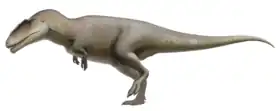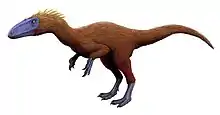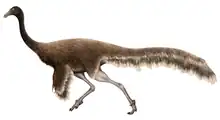Xuanhanosaurus
Xuanhanosaurus (meaning "Xuanhan lizard") is a genus of theropod dinosaur that lived during the Middle Jurassic (Bathonian) of the Sichuan Basin, China, around 166.0 million years ago.[2] This Taxon represents one of the various Carnosaurian taxa found on the Middle Jurassic of the region, uncovered on the Lower Shaximiao Formation.[3] Although it has been known for more than 40 years, this taxon has been the subject of very few studies, although most seem to agree that it is a Tetanuran, possibly a basal Allosauroid, highlighting the fact that it has a vestigial fourth metacarpal.
| Xuanhanosaurus | |
|---|---|
 | |
| An artist's restoration of Xuanhanosaurus qilixiaensis | |
| Scientific classification | |
| Domain: | Eukaryota |
| Kingdom: | Animalia |
| Phylum: | Chordata |
| Clade: | Dinosauria |
| Clade: | Saurischia |
| Clade: | Theropoda |
| Genus: | †Xuanhanosaurus Dong, 1984 |
| Species: | †X. qilixiaensis |
| Binomial name | |
| †Xuanhanosaurus qilixiaensis Dong, 1984 | |
Discovery
The type species Xuanhanosaurus qilixiaensis was named by Dong Zhiming in 1984. The generic name refers to Xuanhan County in Sichuan, while the specific name is derived from the town of Qilixia. The specimen was recovered in 1979, when the author was conducting a Dinosaurian Fossil survey in Sichuan Province, when was guided by Liu Yawen and the 137th team to examine the Qilixia section, where they recovered the holotype of this new taxon at the southern flank of the Qili Dorsal Slope.[3] The holotype specimen, IVPP V.6729, was found in China's Lower Shaximiao Formation. It consists of a partial skeleton without a skull, namely a scapula missing the posterior end, coracoid, a possible sternum humerus, radius, ulna, manus, as well a few fragmentary dorsal vertebrae.[3]
Description

Xuanhanosaurus, originally thought to be around 6 m long, was approximately 4.5 meters (15 ft) in length, with a weight of 250 kilograms (550 lb).[5] Xuanhanosaurus had powerful forelimbs, over 65 cm long; this, along with the retention of the fourth metacarpal in the hand, led Dong to suggest that Xuanhanosaurus might have walked on all four legs. If so, it would be the only known four-legged meat-eater among dinosaurs.[3] Later paleontologists have not agreed with Dong's original assessment. They think this dinosaur walked on its hind legs as other theropods did, pronation of the lower arm being impossible. The strong arms could instead have been useful in catching prey.[6] The retention of the 4th metarcarpal is the most notorious feature of this taxon, yet the presence of a convex proximal surface on the distal carpal 2 has been used to arge it represents a second stage in the evolution of the "semilunate" carpal.[7] Some recent work have notified that beyond the 4th metarcarpal, Xuanhanosaurus also retains ceratosaurian-like short phalanges II-1, similar in length to the ones recovered on Saltriovenator.[8] The scapula was found to be bulkier than in Allosaurus. The distal humerus is enlarged laterally, forming a one-inch step.[3] The vertebrae are posteriorly concave and anteriorly protruding, with cervical centra having flat anterior articular surfaces, also seen in Condorraptor, Piatnitzkysaurus and "Szechuanosaurus" zigongensis, yet lacking posterior pneumatic foramen or fossa, which is seen on the first 2 genera.[9]
Phylogeny
Originally, Xuanhanosaurus was assigned by Dong to the Megalosauridae, when this group was meant to include a larger amount of taxa, and was argued to be in the middle stage of the evolution of the Tetanureae due to it´s vestigial 4th metacarpals.[3] Latter it was found by Roger Benson in 2009 to belong to a primitive lineage of the Megalosauroidea.[10] A more recent study by Benson and colleagues in 2010 found that it was more likely to be the most primitive known member of the Metriacanthosauridae family.[4] In 2018, based on several conditions such as the length and retention of the vestigial 4th metacarpal, it was argued that this taxon and "Szechuanosaurus" zigongensis belong to early-diverging branches of the ceratosaurian-tetanuran node.[8] In 2019, Rauhut and Pol recovered Xuanhanosaurus outside of Metriacanthosauridae, as the basalmost member of Allosauroidea.[6]
| Carnosauria |
| ||||||||||||||||||||||||||||||||||||||||||||||||
References
- Zhou, Yuxuan; Dai, Hui; Yu, Haidong; Ma, Qingyu; Tan, Chao; Li, Ning; Lin, Yu; Li, Deliang (2022). "Zircon geochronology of the new dinosaur fauna in the Middle Jurassic lower Shaximiao Formation in Chongqing, SW China". Palaeogeography, Palaeoclimatology, Palaeoecology. 592: 110894. Bibcode:2022PPP...592k0894Z. doi:10.1016/j.palaeo.2022.110894. ISSN 0031-0182. S2CID 247000432.
- Holtz, Thomas R. Jr. (2011) Dinosaurs: The Most Complete, Up-to-Date Encyclopedia for Dinosaur Lovers of All Ages, Winter 2010 Appendix.
- Dong, Z. (1984). "A new theropod dinosaur from the Middle Jurassic of Sichuan Basin". Vertebrata PalAsiatica. 22 (3): 213–218. Retrieved 10 July 2023.
- Benson, R. B. J.; Carrano, M. T; Brusatte, S. L. (2010). "A new clade of archaic large-bodied predatory dinosaurs (Theropoda: Allosauroidea) that survived to the latest Mesozoic". Naturwissenschaften. 97 (1): 71–78. Bibcode:2010NW.....97...71B. doi:10.1007/s00114-009-0614-x. PMID 19826771. S2CID 22646156. Supporting Information
- Paul, G.S. (2010). The Princeton Field Guide to Dinosaurs. Princeton University Press. p. 86. ISBN 9780691137209.
- Rauhut, Oliver W. M.; Pol, Diego (2019-12-11). "Probable basal allosauroid from the early Middle Jurassic Cañadón Asfalto Formation of Argentina highlights phylogenetic uncertainty in tetanuran theropod dinosaurs". Scientific Reports. 9 (1): 18826. Bibcode:2019NatSR...918826R. doi:10.1038/s41598-019-53672-7. ISSN 2045-2322. PMC 6906444. PMID 31827108.
- Xu, X.; Han, F.; Zhao, Q. (2014). "Homologies and homeotic transformation of the theropod 'semilunate' carpal". Scientific Reports. 4 (1): 6042. Bibcode:2014NatSR...4E6042X. doi:10.1038/srep06042. PMC 4131224. PMID 25116378.
- Dal Sasso, Cristiano; Maganuco, Simone; Cau, Andrea (2018-12-19). "The oldest ceratosaurian (Dinosauria: Theropoda), from the Lower Jurassic of Italy, sheds light on the evolution of the three-fingered hand of birds". PeerJ. 6: e5976. doi:10.7717/peerj.5976. ISSN 2167-8359. PMC 6304160. PMID 30588396.
- Hui Dai; Roger Benson; Xufeng Hu; Qingyu Ma; Chao Tan; Ning Li; Ming Xiao; Haiqian Hu; Yuxuan Zhou; Zhaoying Wei; Feng Zhang; Shan Jiang; Deliang Li; Guangzhao Peng; Yilun Yu; Xing Xu (2020). "A new possible megalosauroid theropod from the Middle Jurassic Xintiangou Formation of Chongqing, People's Republic of China and its implication for early tetanuran evolution". Scientific Reports. 10 (1): Article number 139. Bibcode:2020NatSR..10..139D. doi:10.1038/s41598-019-56959-x. PMC 6954265. PMID 31924836.
- Benson, R. B. J. (2010). "A description of Megalosaurus bucklandii (Dinosauria: Theropoda) from the Bathonian of the UK and the relationships of Middle Jurassic theropods". Zoological Journal of the Linnean Society. 158 (4): 882–935. doi:10.1111/j.1096-3642.2009.00569.x.


.jpg.webp)











